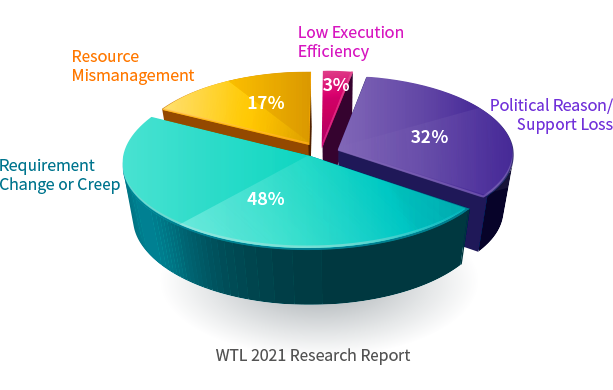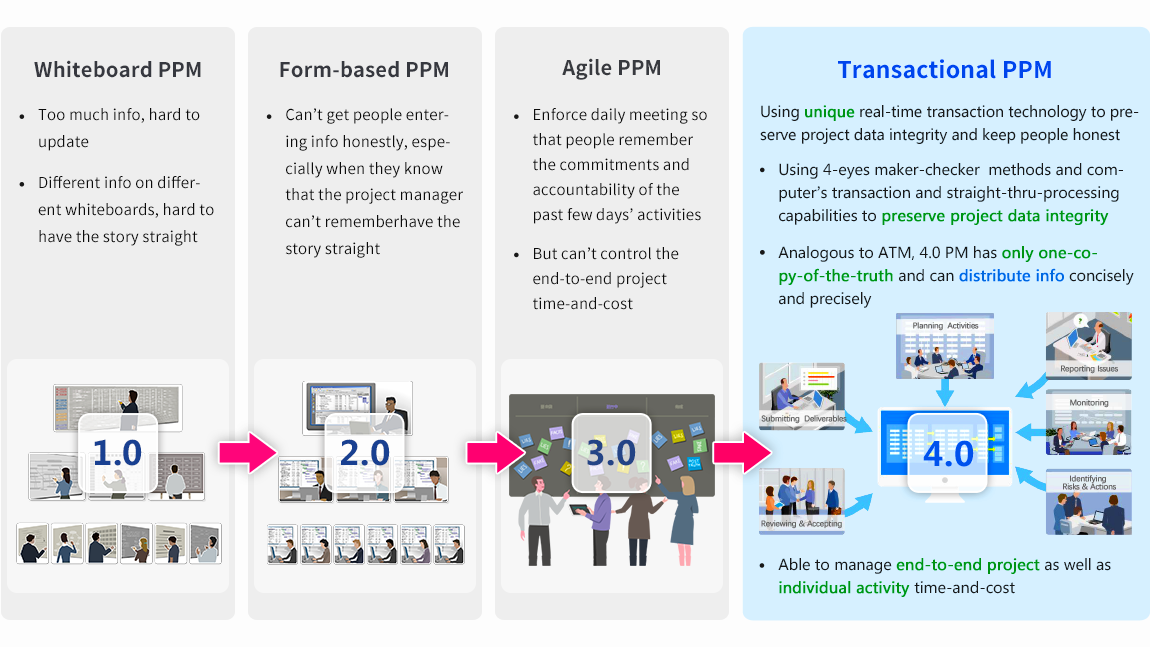
- Control Causes of Project Failure
The biggest cause of project failure is not lack of budget. If the project sponsor or project manager does think the project is under budget, they won't let the project begin. If the project manager does not report an insufficient budget until the project is delayed with a cost overrun, budgetary and mismanagement issues will be mixed. Ultimately, the project sponsor cancels the project or is forced to increase the budget.

According to our research, the biggest cause of project failure is that the project took time and cost, but stakeholders were not satisfied with the results. To avoid the above incentives, the most important thing is to control (i) requirements, (ii) human resources and (iii) project execution efficiency. See below:

- Requirement Management
PPM 4.0 Requirement Management allows you to (i) identify and number each requirement, (ii) identify who proposes and is responsible for each requirement and its priority, (iii) what tests need to pass to reach a consensus that the requirement is realized and (iv) set a requirement baseline. Whether you are using agile, PMBOK or other methodologies, these four things are essential to requirement management, especially (iii).

1. Bad requirement
Make a list of functions and tests using PPM 4.0. It's a good idea to check this list against each requirement to ensure that all of them are being completed smoothly.
2. Conflicting requirements
Use PM 4.0 to document and publish stakeholder requirements, schedule meetings with all stakeholders, and resolve issues with a clear understanding of conflicting requirements.
3. Undocumented processes
Proper documentation is key. Use PPM 4.0 to note down all existing business processes and differences between different users. Provide this information to relevant stakeholders and higher management. If possible, create and maintain an up-to-date document library of existing business processes and operating procedures within your job responsibilities.
4. Change priorities
You need a change management process to document and publicize every requirement change and its impact. If you don't have any systematic process for handling requirement changes, you'll end up with more changes because each change doesn't cause any loss to stakeholders and indirectly encourages them not to think so carefully in advance. Changes in requirements are not entirely avoidable. But you have to get people to think carefully at the beginning of the project and do your best to limit changes after the requirements are signed off. For unavoidable changes, you must use PPM 4.0 to accurately record and publish their influence to make project stakeholders understand their benefits and costs.
5. Lack of access to end users
When you use PPM 4.0 for requirement data recording and publishing, your persuasiveness will come in handy. Show your case to project sponsors and convince them why it's critical to observe real users at work and understand how each activity is performed. Doing this gives you a clear picture of the types of problems your users face in their day-to-day work.
- Resource Management

1. Skills in deploying competent resources at the right cost
PPM 4.0 Resource Management will help you with resource management. Having the right resources and skills are critical to completing the project within the budgeted time and cost. You can instantly identify and assign competent resources in a project, and select resources based on their availability, skills, qualifications, location, team, resource cost rate, and other criteria, or with enterprise-wide visibility.
2. Tips for reducing resource costs
Using PPM 4.0 Resource Management solution will help you significantly reduce resource costs, minimize under-/over-skilled resources in your projects, and allow you to utilize cost-effective nationwide resources without compromising quality.
PPM 4.0 Resource Management enables you to avoid last-minute recruitment costs with proper capacity planning. It minimizes hire/fire cycles by aligning project workloads with workforce capabilities.
3. Tips for controlling project costs in advance
You don't want last-minute budget overruns to create roadblocks for your project. To avoid this, you need to forecast and track various financial attributes, namely costs, revenues, profit margins, and overhead. PPM 4.0 Resource Management solution can help you take corrective actions in advance and control project costs.
4. Tips for predicting and ensuring that too much capacity is not wasted
In many enterprises, excess resource capacity is overlooked, wasted, and ultimately used for unbilled activities.
PPM 4.0 Resource Management solution uses advanced capacity planning techniques to foresee excess resources. Decision-makers can take corrective action ahead of time and assign billing items to resources.
5. Tips to increase employee productivity
Significantly increase employee productivity by:
- Assign work based on employees’ abilities and areas of interest
- Empower employees to work on projects that interest them
- Retrain staff to fill future resource capacity and skill gaps
6. Tips for building an on-demand workforce to reduce costs
In a volatile environment, effective resource capacity planning can help you predict future resource surpluses or shortages in response to changing demands.
PPM 4.0 resource management solution assists your company to proactively hire workforce on demand, from contractors, professional resource providers, freelancers, part-time professionals, etc.
- Execution Efficiency

These four generations of PPM are now all in use. The reason why PPM1.0 is still used is that its data reliability is higher than that of PPM2.0, whose design is limited to the technology of the time with low-quality or nonsensical data “garbage-in, garbage-out”, while PPM 3.0 is more of a methodology than a tool.
Due to the limitation of “garbage-in, garbage-out”in the previous PPM, the project progress reflected may be different from the actual situation (for example, the system reveals that 90% of the project is completed, but the actual rate is only 50% or even lower). This phenomenon is common in project management (The Myth of 90% Complete), which indicates that the project has a problem with data integrity.
PPM 4.0 uses Online Transaction Processing (OLTP) technology while applying the Four Eyes Principle and Prisoners Dilemma to maintain the integrity of project data. With high-quality data, the project manager can immediately find out the reason for the first delayed activity and make up for it before the occurrence of The Myth of 90% Complete.
Every activity responsible person knows who he depends on, and when he detects that someone he depends on faces delays, he will slow down. Once those who rely on him detect it, they will follow suit. Then the project began to have a domino effect, and finally encountered an overall slowdown. Therefore, the integrity of the project data is the key to the effective execution of the project team, because it can prevent the overall slowdown from happening.








